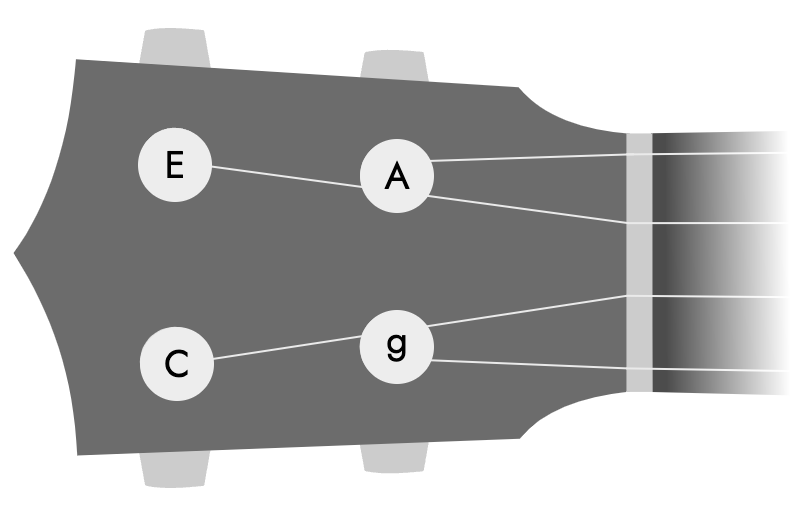



- gCEA standard tuning is by far the most commonly used ukulele tuning. If the tuning isn't specified for a song or chord sheet, you can assume it's using this tuning.
- aDF#B tuning is shifted two frets up, and brings out a sweeter and brighter ukulele tone with higher pitches. DGBE tuning is more common for larger ukuleles, and gives the same root notes as the top four strings on a guitar (in standard tuning).
- fA#DG tuning brings standard tuning down two frets for a lower sounding tone.
It can be useful to think of the tuning pegs on your ukulele as being ordered clockwise, starting with the peg that is closest to your body. Here is an example of how that would look, as each peg corresponds to one string:

- Tuning works best in a quiet environment, so try to avoid background noise.
- Keep the ukulele close to the microphone.
- Try adjusting the microphone sensitivity in your device settings.
How To Tune a Ukulele
All instruments need to be set to exact pitches in order to play music in modern scales. This process is called tuning, in which the instrument is carefully tuned to specific pitches. String instruments like the ukulele have tuning pegs, which can be turned in both directions to either raise or lower the pitch that corresponds to one of the ukulele strings. Each time you play your ukulele, it is very important to ensure that the instrument is in tune. This is particularly important when playing with other musicians, in order to create harmonies and avoid discordant sounds. Below, we'll go through more details of the common ukulele tunings.
Microphone Ukulele Tuner
The simplest method for tuning a ukulele is to use a microphone-based tuner. You can play each string on the ukulele directly into a microphone, which can provide real-time feedback as you play. You will be able to see visually whether the note is either too flat or too sharp, which you can use to adjust the tension of the ukulele string. As long as you are on a device with a microphone (like a phone, tablet, or laptop), you can use our microphone-based tuner above.
Ukulele Tunings
While the ukulele can be tuned to a wide range of notes, there are a handful of commonly used tunings that are recommended for playing popular music. It is recommended to use these tunings, but other tunings can be useful for more experimental work. On the uke, the botttom-most string is typically tuned to a note that is higher than the note on the 2nd bottom-most string. Tunings denote this with a lower case letter, as in the standard tuning, gCEA. Each of the four letters of the tuning name denote the corresponding string on the ukulele, starting from the bottom (the string closest to your chest).
gCEA — Standard Tuning
The most popular ukulele tuning is known as gCEA. The vast majority of song tabs, chord charts, and other ukulele resources, are written with the assumption of gCEA ukulele tuning. This makes it the easiest tuning option for playing along to songs, or when jamming with other uke players. This tuning makes it very easy to play in the key of C major, which is a popular song key for a lot of music.
aDF#B — D Tuning
D Tuning, which uses the notes aDF#B, takes the original standard tuning and shifts everything up by one whole tone (two frets). Just like how standard tuning makes it easy to play in the key of C major, this D tuning makes it simple to play in the key of D major. This tuning was more popular during the 1920s and 1930s, so it will match up better when playing songs from that era. It's also a better fit for sopranino ukuleles and sopranissimo ukuleles given their shorter scale lengths.
DGBE — Chicago Tuning
The DGBE tuning, which is sometimes referred to as Chicago tuning, is more popular on some of the larger ukuleles, and is the most common tuning on the baritone ukulele. This tuning matches up exactly with the top 4 strings of the guitar in standard tuning. Because of this, DGBE tuning works very well when translating songs and chords between guitar and ukulele. It is an excellent tuning for playing along to more guitar-based songs.
fA#DG — A#/Bb Tuning
The fA#DG tuning is less common than other ukulele tunings, but it still useful in some situations. This ukulele tuning shifts all musical pitches down by one whole tone (two frets), which makes it easier to play music in the key of A#/Bb. This tuning is also useful for cases where you would like to bring the ukulele pitches slightly lower, to fit with certain song keys that benefit from access to these lower notes, or to make it easier to sing along in certain musical keys.
